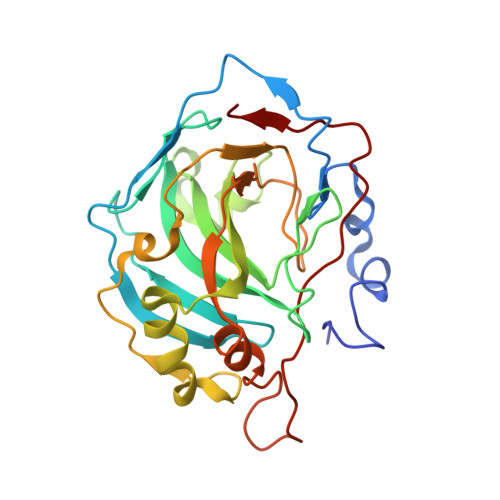Antigen specificity and high affinity binding provided by one single loop of a camel single-domain antibody.
Desmyter, A., Decanniere, K., Muyldermans, S., Wyns, L.(2001) J Biological Chem 276: 26285-26290
- PubMed: 11342547
- DOI: https://doi.org/10.1074/jbc.M102107200
- Primary Citation of Related Structures:
1G6V - PubMed Abstract:
Detailed knowledge on antibody-antigen recognition is scarce given the unlimited antibody specificities of which only few have been investigated at an atomic level. We report the crystal structures of an antibody fragment derived from a camel heavy chain antibody against carbonic anhydrase, free and in complex with antigen. Surprisingly, this single-domain antibody interacts with nanomolar affinity with the antigen through its third hypervariable loop (19 amino acids long), providing a flat interacting surface of 620 A(2). For the first time, a single-domain antibody is observed with its first hypervariable loop adopting a type-1 canonical structure. The second hypervariable loop, of unique size due to a somatic mutation, reveals a regular beta-turn. The third hypervariable loop covers the remaining hypervariable loops and the side of the domain that normally interacts with the variable domain of the light chain. Specific amino acid substitutions and reoriented side chains reshape this side of the domain and increase its hydrophilicity. Of interest is the substitution of the conserved Trp-103 by Arg because it opens new perspectives to 'humanize' a camel variable domain of heavy chain of heavy chain antibody (VHH) or to 'camelize' a human or a mouse variable domain of heavy chain of conventional antibody (VH).
- Department Ultrastructure, Vlaams Interuniversitair Instituut voor Biotechnologie, Vrije Universiteit Brussel, Paardenstraat 65, B-1640 Sint Genesius Rode, Belgium. aldesmtr@vub.ac.be
Organizational Affiliation:


















